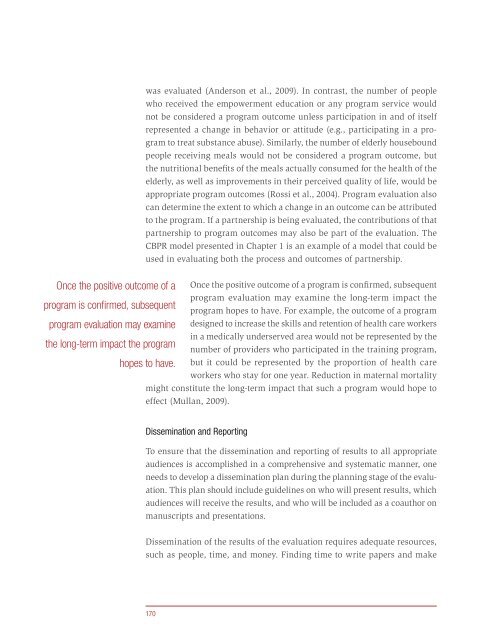Principles of Community Engagement (Second Edition)
Principles of Community Engagement (Second Edition)
Principles of Community Engagement (Second Edition)
Create successful ePaper yourself
Turn your PDF publications into a flip-book with our unique Google optimized e-Paper software.
Once the positive outcome <strong>of</strong> a<br />
program is confirmed, subsequent<br />
program evaluation may examine<br />
the long-term impact the program<br />
was evaluated (Anderson et al , 2009) In contrast, the number <strong>of</strong> people<br />
who received the empowerment education or any program service would<br />
not be considered a program outcome unless participation in and <strong>of</strong> itself<br />
represented a change in behavior or attitude (e g , participating in a program<br />
to treat substance abuse) Similarly, the number <strong>of</strong> elderly housebound<br />
people receiving meals would not be considered a program outcome, but<br />
the nutritional benefits <strong>of</strong> the meals actually consumed for the health <strong>of</strong> the<br />
elderly, as well as improvements in their perceived quality <strong>of</strong> life, would be<br />
appropriate program outcomes (Rossi et al , 2004) Program evaluation also<br />
can determine the extent to which a change in an outcome can be attributed<br />
to the program If a partnership is being evaluated, the contributions <strong>of</strong> that<br />
partnership to program outcomes may also be part <strong>of</strong> the evaluation The<br />
CBPR model presented in Chapter 1 is an example <strong>of</strong> a model that could be<br />
used in evaluating both the process and outcomes <strong>of</strong> partnership<br />
Once the positive outcome <strong>of</strong> a program is confirmed, subsequent<br />
program evaluation may examine the long-term impact the<br />
program hopes to have For example, the outcome <strong>of</strong> a program<br />
designed to increase the skills and retention <strong>of</strong> health care workers<br />
in a medically underserved area would not be represented by the<br />
number <strong>of</strong> providers who participated in the training program,<br />
but it could be represented by the proportion <strong>of</strong> health care<br />
workers who stay for one year Reduction in maternal mortality<br />
might constitute the long-term impact that such a program would hope to<br />
effect (Mullan, 2009)<br />
hopes to have.<br />
Dissemination and Reporting<br />
To ensure that the dissemination and reporting <strong>of</strong> results to all appropriate<br />
audiences is accomplished in a comprehensive and systematic manner, one<br />
needs to develop a dissemination plan during the planning stage <strong>of</strong> the evaluation<br />
This plan should include guidelines on who will present results, which<br />
audiences will receive the results, and who will be included as a coauthor on<br />
manuscripts and presentations<br />
Dissemination <strong>of</strong> the results <strong>of</strong> the evaluation requires adequate resources,<br />
such as people, time, and money Finding time to write papers and make<br />
170

















